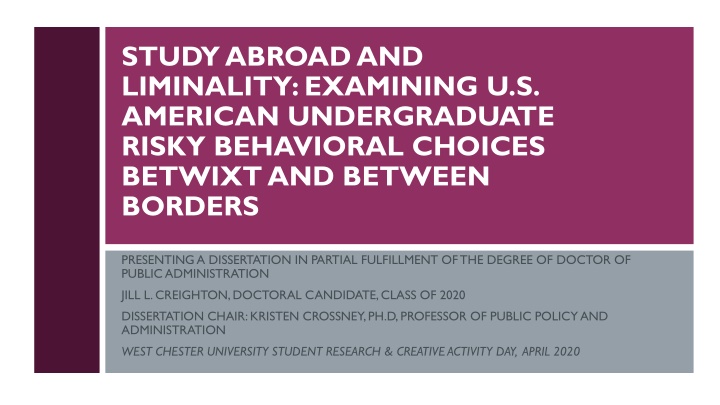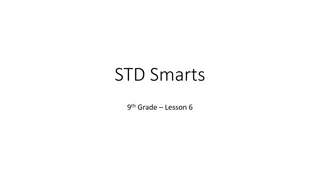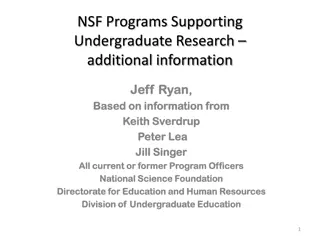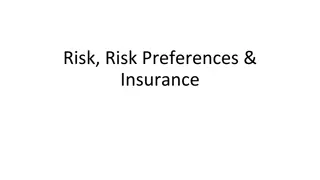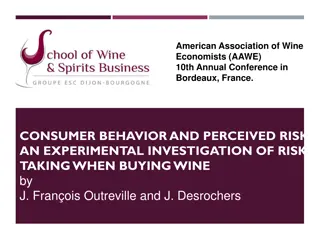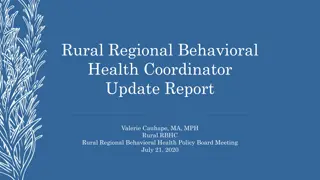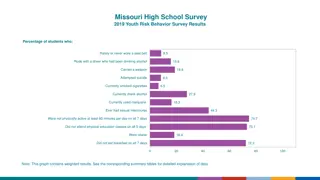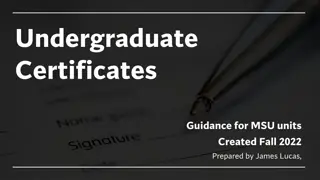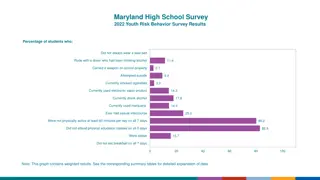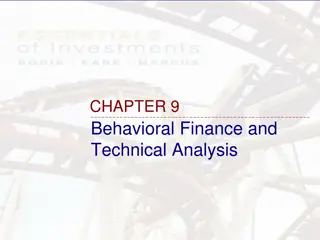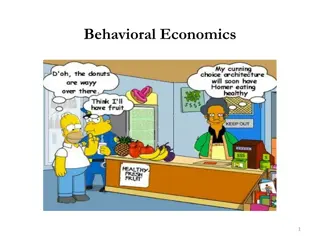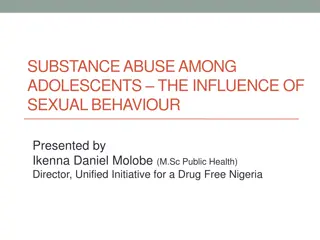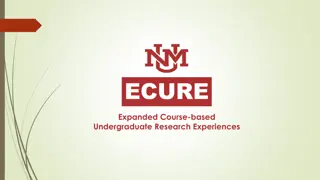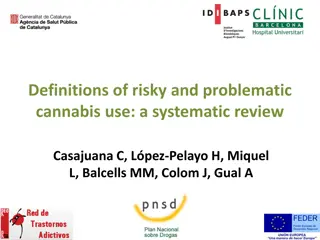U.S. American Undergraduate Risky Behavioral Choices
This dissertation delves into the risky behavioral decisions of U.S. American undergraduate students, specifically focusing on their behaviors while studying abroad. It aims to explore the changes in risky behaviors between home and study abroad environments, factors influencing such behaviors, and students' experiences of liminality. The study sheds light on the intersections of public administration, higher education administration, and global perspectives in shaping student behaviors.
Download Presentation

Please find below an Image/Link to download the presentation.
The content on the website is provided AS IS for your information and personal use only. It may not be sold, licensed, or shared on other websites without obtaining consent from the author.If you encounter any issues during the download, it is possible that the publisher has removed the file from their server.
You are allowed to download the files provided on this website for personal or commercial use, subject to the condition that they are used lawfully. All files are the property of their respective owners.
The content on the website is provided AS IS for your information and personal use only. It may not be sold, licensed, or shared on other websites without obtaining consent from the author.
E N D
Presentation Transcript
STUDY ABROAD AND LIMINALITY: EXAMINING U.S. AMERICAN UNDERGRADUATE RISKY BEHAVIORAL CHOICES BETWIXT AND BETWEEN BORDERS PRESENTING A DISSERTATION IN PARTIAL FULFILLMENT OF THE DEGREE OF DOCTOR OF PUBLIC ADMINISTRATION JILL L. CREIGHTON, DOCTORAL CANDIDATE, CLASS OF 2020 DISSERTATION CHAIR: KRISTEN CROSSNEY, PH.D, PROFESSOR OF PUBLIC POLICY AND ADMINISTRATION WEST CHESTER UNIVERSITY STUDENT RESEARCH & CREATIVE ACTIVITY DAY, APRIL 2020
BACKGROUND & DISCIPLINARY CONTEXT One of the most niche sub-arenas of public administration, higher education administration, involves preparing future leaders and scholars for global perspectives U.S. higher education institutions send over 300,000 U.S. American college students to embark on a study abroad journey annually (Farrugia & Bhandari, 2014) The higher education sub-fields of study abroad, international education, health promotion, student conduct, and risk management have begun to quantify the risky decisions made by U.S. American undergraduate students both in the home, collegiate environment and during the study abroad experience (American Health Association, 2015; The Forum on Education Abroad, 2016; Leigh, 1999; Pedersen, LaBrie, Hummer, Larimer, & Lee, 2010; Van Tine, 2011) A significant gap in the literature exists to explain the context and rationale for such risky behaviors. Students seem to be engaging in riskier behaviors while studying abroad compared to how they behave while at their home institutions (Pedersen et al, 2010) The goal of this research was to learn whether or not the study abroad experience explained changes in undergraduate students engagement in risky behaviors.
PRIMARY RESEARCH QUESTIONS Three primary research questions guided this study: 1. Do traditionally-aged, undergraduate student risky behavioral decisions change between the collegiate environment and the SA environment? If so, how? 2. Does age, gender, or previous alcohol use impact students risky behavior while studying abroad? 3. With which components of liminality do students self-identify as having experienced while studying abroad?
This dissertation lives in the nexus of four major areas contained within the higher education, tourism, and sociology discourses: Undergraduate risky behavior in a domestic context provides a sense of context for how students engage across 5 domains of risk: Academic Financial Intimate Relationships LITERATURE REVIEW KEY AREAS Alcohol Other Substances U.S. American students who have studied abroad addresses which students study abroad, where they go, the value of the study abroad experience, and criticisms of study abroad programs Tourism literature, including eco and disaster tourism, poverty and slum tourism, and university alternative break tourism Liminality and liminal space demonstrates a conceptual perspective from which the risky behaviors of students while studying abroad can be explained
NOTES ON LIMINALITY AND LIMINAL SPACE (STUDY S CONCEPTUAL PERSPECTIVE) Liminality, an anthropological, ethnographic concept incepted by Van Gennep (1960), describes the physical and psychological space that exists in the in between. Turner (1967) broadened liminality to a more generalizable human experience of being betwixt and between (Turner, 1967, p. 1). The betwixt and between describes the nature of the period of individual development that occurs amidst the state of transition between societal constructs. Societal structures cease to bind during study abroad students have one foot in and one foot out of each society. Both short and long-term sojourning correlated to increases in both openness and agreeableness while decreasing in neuroticism. Study identifies new international relationships as a primary factor in the process of personality change while abroad (Zimmerman and Neyer, 2013) Tenets of liminality used in this study: boundarylessness, feeling free to try new behaviors, feeling like the rules of everyday life did not apply, and/or the betwixt and between
METHODOLOGY AND METHODS Epistemology: Post-positivist Methodology: Quantitative Non-experimental design Methods: Original survey created, analyzed using descriptive and inferential statistics Participants identified through non- probability sampling in partnership with a public higher education institution located on the east coast of the United States, aka the site Study participant inclusion criteria Must have departed between 2017-2019 Study abroad duration was short-term (one semester or less) to retain sense of liminal space Participant must be traditionally-aged (18-24) and pursuing first bachelor s degree Self-identify as U.S. American by culture regardless of citizenship or documentation status 14 multiple choice questions, one open- ended survey question asked participants to share a story about risk taking during their study abroad experience
STUDY LIMITATIONS Non-experimental design results in correlations, but not causations No cause and effect results available Original survey not yet validated Study results generalizable only to the site and to those falling within the study s inclusion criteria Cannot be extrapolated to students over 25 or students originating their study abroad experience from any other country Many study abroad participants come from privileged socioeconomic strata and other privileged identities Study does not disaggregate what impact socioeconomic status might have on risky behavior Does not dive into the social equity and inclusion components of the study abroad experience Experiences of students of color, students identifying gender as non-binary, students identifying as LGBTQQIA+, etc., may have critically different experiences
FOCUSED RESEARCH QUESTIONS FOCUSING AND EXPANDING ON THE OVERARCHING RESEARCH QUESTIONS, THIS STUDY SOUGHT TO ANSWER THE FOLLOWING, SPECIFIC QUESTIONS THAT COULD BE ADDRESSED USING STATISTICAL TESTS: Research Question 1: Is there a correlation between pre-study abroad and during study abroad risky behavior patterns among students? Sub-Question 1.3: Does engagement in alcohol- related pre-study abroad risky behavior matter in identifying higher risk behavior during study abroad? Sub-Question 1.1: Does the variable of age matter in identifying higher risk behavior during study abroad? Sub-Question 1.2: Does the variable gender matter in identifying higher risk behavior during study abroad? Research Question 2: Does a relationship exist between students reporting engaging in risky behaviors during study abroad and the tenets of liminality (boundarylessness, feeling free to try new behaviors, feeling like the rules of everyday life did not apply, and/or the betwixt and between)?
STUDY VARIABLES Personality Change** PerCha 1 1-5 5 Level of agreement the traveler changed aspects of their personality while abroad Variable Abbre- viation Risk Factors Ordin al Scale Theoretic al Maximum Description Academic* Acad 3 1-4 12 Level of engagement in academic risky behaviors Physical Appearanc e** PhysApp 1 1-5 5 Level of agreement the traveler changed their physical appearance while abroad Financial* Fin 3 1-4 12 Level of engagement in financial risky behaviors Friend Similarity** Friend 1 1-5 5 Level of agreement the traveler s friends were similar at home and abroad Intimate Relationships * Relat 4 1-4 16 Level of engagement in intimate relationship risky behaviors Good Decisions** Decis 1 1-5 5 Level of agreement the traveler made good decisions while abroad Alcohol* Alc 7 1-4 28 Level of engagement in alcohol- related risky behaviors Pushed Boundaries ** Bound 1 1-5 5 Level of agreement the traveler pushed their own boundaries while abroad Other Substances* Subst 6 1-4 24 Level of engagement in other substances-related risky behaviors One Risk Taken** OneRisk 1 1-5 5 Level of agreement the traveler performed at least one risky behavior while abroad Home Rules** HRules 1 1-5 5 Level of agreement the rules of the home environment applied abroad Not at Home** NHome 1 1-5 5 Level of agreement the traveler engaged in at least one behavior they would not have while at home Try New Things** TryNew 1 1-5 5 Level of agreement the traveler felt free to try new things while abroad *Variable capturing the 5 domains of risk. **Variable capturing a tenet of liminality
Respondent Category Frequency % Age at time of study abroad departure N=147 18-20 years of age 72 48.98% 20-24 years of age 75 51.02% Class standing at time of study abroad departure N=147 % Freshman 8 5.44% Sophomore 27 18.37% Junior 70 47.62% RESPONDENT CHARACTERISTICS Senior 43 29.25% Gender identity N=147 Cis-gender woman 107 72.11% Cis-gender man 33 23.81% Transgender man 1 0.68% Gender non-binary 2 1.36% Another gender 3 2.04% Self-reported socio-economic status N=147 Living at or below the poverty line 8 5.44% Lower middle class 21 14.29% Middle class 76 51.70% Upper middle class 39 26.53% Wealthy 3 2.04
RESULTS FOR RESEARCH QUESTION 1: IS THERE A CORRELATION BETWEEN PRE-STUDY ABROAD AND DURING STUDY ABROAD RISKY BEHAVIOR PATTERNS AMONG STUDENTS? Correlations: Pre-Study Abroad Risk with During Study Abroad Risk Pre-Study Abroad Risk and Cis-Man Bivariate Regression Variable PAcad PFin PRelat PAlc PSubst PRiskTot Variable DF F B SE(B) SAAcad SAFin SARelat SAAlc SASubst SARiskTot 0.25* SA total risk score (DV) 2 13.50*** 0.52*** Pre-study abroad risk total 0.33*** 0.06 0.19* 0.48*** Cis-gender man 0.01 1.34 0.49*** 0.27* N=147, R2 = 0.16, *p < .05 **p<.01 *** p < .001 0.26** 0.33*** 0.22** 0.36*** 0.40*** Alcohol risk pre-study abroad and total study abroad risk Regression *p < .05 **p<.01 *** p < .001 Overall During Study Abroad Risk by Pre-Study Abroad Risk Regression Variable DF F B SE(B) Alcohol pre-study abroad risk score 1 21.12 0.82*** 0.18 Variable Pre-study abroad total risk score N=147, R2 = 0.16, *p < .05 **p<.01 *** p < .001 DF 1 F B SE(B) 0.06 27.19 0.33*** N=147, R2 = 0.13, *p < .05 **p<.01 *** p < .001
RESULTS FOR RESEARCH QUESTION 2: DOES A RELATIONSHIP EXIST BETWEEN STUDENTS REPORTING ENGAGING IN RISKY BEHAVIORS DURING STUDY ABROAD AND THE TENETS OF LIMINALITY? & GRAND RESULT Liminality Tenets Correlations Totality of Study Abroad Risk Variable FreeTry PerCha Phys App 0.18* 0.21* 0.12 0.15 0.09 0.22** Bound NHome OneRisk Variable SA total risk score (DV) Pre-study abroad risk total Cis-gender men Age 21+ OneRisk NHome FreeTry N=147, R2 = 0.28, *p < .05 **p<.01 *** p < .001 DF 6 F B SE(B) 9.04*** SAAcad SAFin SARelat SAAlc SASubst SARiskTot *p < .05 **p<.01 *** p < .001 0.14 0.13 0.07 0.19* 0.01 0.17* 0.21** 0.16* 0.10 0.26** 0.16 0.26** 0.05 0.10 0.05 0.20* 0.11 0.16 0.14 0.14 0.13 0.18* 0.08 0.19* 0.28*** 0.29*** 0.13 0.34*** 0.14 0.37*** 0.31*** 0.58 2.18 4.16*** 0.45 1.21 0.06 1.29 1.13 1.21 1.18 1.62 Inverse Liminality Tenets Correlations Variable SAAcad SAFin SARelat SAAlc SASubst SARiskTot *p < .05 **p<.01 *** p < .001 HRules 0.30*** 0.22** 0.08 0.26** 0.21* 0.31*** Friend 0.12 0.10 0.02 0.13 0.18 0.15 Decis 0.35*** 0.35*** 0.30*** 0.40*** 0.32*** 0.49*** Students make riskier choices during study abroad than while in their home environment; this is compounded when students are already predisposed to risky behavior while at home Students over 21 years of age are less likely to make risky behavioral choices during study abroad When students self-report experiencing the tenets of liminality, they are more likely to make riskier choices during study abroad
9 SIGNIFICANT FINDINGS Finding 1: Traditionally-Aged Undergraduate Students do Engage in Riskier Behaviors While Abroad as Compared to their Behavior in the Home Context Finding 2: Students Who Engage in Risky Behaviors Prior to Study Abroad (SA) Engage in Even Riskier Behaviors While Studying Abroad Finding 3: Students Aged 21-24 Make Less Risky Choices Than Those Aged 18-20 During SA Finding 4: Cis-Gender Men Make Riskier Behavioral Choices Than Students of Other Genders Only When Already Making Risky Behavioral Choices in The Home Context Finding 5: Pre-SA Alcohol Risky Behaviors Serve as Important Predictors of Risk-Taking Behaviors During SA Finding 6: Self-Reporting Experiences in Liminal Space Directly Relates to an Increase in Risky Behaviors During SA Finding 7: Self-Reporting a Lack of Liminal Experience Correlates to a Decrease in Risky Behaviors During SA Finding 8: Not All Choices in Liminal Space are Risky Grand Finding: SA Risky Behavioral Choices Were Best Explained by Self-Reporting Engaging in at Least One Risky Behavior in Combination with Pre-Departure Risky Behavioral Choices. This critical component of this finding shows that the tandem contribution of pre-SA personal choices with the intersection of liminal space really comprise the primary ingredients for future risky behavior when the SA experience finally arrives. The recipe for risk is not just previous risk or the presence of liminal space. The recipe for risk, significantly, is both.
IMPLICATIONS FOR FUTURE PRACTICE & RESEARCH Practice Recommendation 1: Expand existing Pre-Departure Education on Harm Reduction Related to Risky Behaviors Across all Risk Domains Practice Practice Recommendation 2: Study Abroad Administrators and Student Conduct Administrators Build Pre-Departure Communication Bridges to Engage in Risk Prevention Practice Practice Recommendation 3: Normalize Liminality and Provide Opportunities for Students to Share their Decision-Making within Liminal Space Practice Repeat Future Research Recommendation 1: Repeat this Study Using a Repeated Measures, Longitudinal Design Future Research Recommendation 2: Use an Experimental Design with Two Cohorts the First with Study Abroad as the Intervention and the Second with Those Staying Home as a Control Group Use Strengthen Future Research Recommendation 3: Strengthen the Definition of Students Conceptualization of Risk and Risky Behavior Future Research Recommendation 4: Investigate Further a Stronger Understanding of how to Study the Phenomenon of how People Experience Liminality and Liminal Space Investigate Future Research Recommendation 5: Include Race Identity as a Component of the Study Abroad Experience and Apply a Critical Theory Perspective Include Future Research Recommendation 6: Focus Research on The Experiences of Cis-Gender Women, Transgender, Gender Non-Binary, Gender Fluid, and Other Gender Identities Through a Critical Lens Focus Approach Future Research Recommendation 7: Approach the Open-Ended Survey Results in this Study from a Qualitative Perspective
THANK YOU FOR REVIEWING THIS RESEARCH! REFERENCES American College Health Association. (2015). National college health assessment IIc: Undergraduate students reference group data report 2015. Retrieved from http://www.achancha.org/docs/NCHAII_WEB_SPRING_2015_UNDERGRADUATE_REFERENCE_GROUP_DATA_%20REPORT.pdf. Farrugia, C., & Bhandari, R. (2014). Open doors report on international education exchange. New York, NY: Institute of International Education. The Forum on Education Abroad. (2016). Insurance claims data and mortality rate for college students studying abroad. Retrieved from https://forumea.org/wpcontent/uploads/2014/08/ForumEA_InsuranceClaims_MortalityRateStudentsAbroad.pdf. Leigh, B. (1999). Peril, chance, adventure: Concepts of risk, alcohol use and risky behavior in young adults. Addiction, 94(3), 371-383. Pedersen, E., LaBrie, J., Hummer, J., Larimer, M., & Lee, C. (2010). Heavier drinking American college students may self-select into study abroad programs: An examination of sex and ethnic differences within a high-risk group. Addictive Behaviors, 35(9), pp. 844-847. Turner, V. (1967). The Forest of Symbols: Aspects of Ndembu Ritual. Ithaca, N.Y.: Cornell University Press. Van Gennep, A. (1960). The Rites of Passage, trans. M.B. Vizedom and G. L. Caffee. Chicago: University of Chicago Press. Van Tine, R. (2011). Liminality and the short-term study abroad experience.(Unpublished master s thesis). University of Illinois at Urbana-Champaign, Urbana, IL. Zimmerman, J. & Neyer, F. (2013). Do we become a different person when hitting the road? Personality development of sojourners. Journal of Personality and Social Psychology, 105(3), 515-530.
